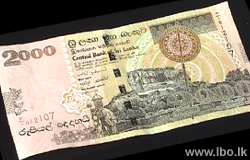At the time, with Sri Lanka still under British rule and two years short of independence, notes were issued by a currency board, with a currency commissioner in charge.

“Sri Lanka’s currency history has two periods - before and after the establishment of the central bank. Before, there were eight denominations of which the highest was ten thousand rupee note,†A Jeewandera, Superintendent of Currency at Sri Lanka’s Central Bank says.
buy priligy online buy priligy online no prescription
“The main transactions which were done with the 10,000 rupee note were inter-bank kind of transactions.â€
With the Central Bank being set up in 1951, the country could issue as many notes as needed.
The Central Bank has been promoting high denomination notes to enhance money as a medium of exchange, given factors like current socio conditions as well as per capita currency holdings.
“For example, in 1981 Central Bank introduced the first high denomination 500 and 1000 notes, while the Colombo Consumer Price Index was in the range of 300. It has now shot up to about 4000 in 2005,†Jeewandera said.
The Bank estimates, out of 145 billion rupees of money circulating throughout the country, 97 percent are currency notes.
Of this, around 75 percent of money is represented in 1000 rupee notes and 15 percent are 500 rupee notes, with the rest in other denominations.
With the introduction of the two thousand rupee note, the significance of the 1000 rupee note is expected to fall to 40 to 50 percent of the currency issue, Jeewandera said.

Higher denomination notes are seen as being more convenient for large value transactions such as buying land or vehicles, with people also carrying fewer notes around.
With the existing 500 rupee note susceptible to counterfeiting, the new 2000 rupee note has several advanced security features.
The features include a four-millimeter wide security thread, with the thread’s colour changing from red to green when the note is tilted.
The note will also have watermarks of the lion in the country’s national flag, fluorescent features and micro-lettering. Tactile bars have been included into the left and right center edges of the note to assist the visually impaired.
The Central Bank says the new note is printed on high quality bank note paper, which would increase the life of the note to around seven to 10 years.
The note could also be folded 7500 to 10,000 times, the bank said, while most other notes in circulation could be folded just 3000 to 4000 times.
